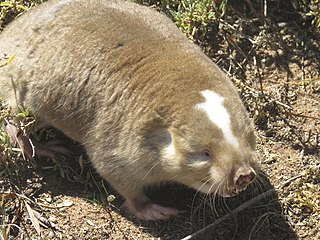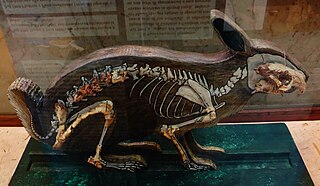
Moles are small mammals adapted to a subterranean lifestyle. They have cylindrical bodies, velvety fur, very small, inconspicuous eyes and ears, reduced hindlimbs, and short, powerful forelimbs with large paws adapted for digging.

Falcons are birds of prey in the genus Falco, which includes about 40 species. Falcons are widely distributed on all continents of the world except Antarctica, though closely related raptors did occur there in the Eocene.

The family Talpidae includes the moles who are small insectivorous mammals of the order Eulipotyphla. Talpids are all digging animals to various degrees: moles are completely subterranean animals; shrew moles and shrew-like moles somewhat less so; and desmans, while basically aquatic, excavate dry sleeping chambers; whilst the quite unique star-nosed mole is equally adept in the water and underground. Talpids are found across the Northern Hemisphere of Eurasia and North America, and range as far south as the montane regions of tropical Southeast Asia.

Ostriches are large flightless birds. They are the heaviest and largest living birds, with adult common ostriches weighing anywhere between 63.5 and 145 kilograms and laying the largest eggs of any living land animal. With the ability to run at 70 km/h (43.5 mph), they are the fastest birds on land. They are farmed worldwide, with significant industries in the Philippines and in Namibia. Ostrich leather is a lucrative commodity, and the large feathers are used as plumes for the decoration of ceremonial headgear. Ostrich eggs have been used by humans for millennia.

Condylura is a genus of moles that contains a single extant species, the star-nosed mole (Condylura cristata) endemic to the northern parts of North America. It is also the only living member of the tribe Condylurini.

The subfamily Talpinae, sometimes called "Old World moles" or "Old World moles and relatives", is one of three subfamilies of the mole family Talpidae, the others being the Scalopinae, or New World moles, and the Uropsilinae, or shrew-like moles.

Desmans are diving insectivores of the tribe Desmanini in the mole family, Talpidae.

The Russian desman is a small semiaquatic mammal that inhabits the Volga, Don and Ural River basins in Russia, Ukraine and Kazakhstan. It constructs burrows into the banks of ponds and slow-moving streams, but prefers small, overgrown ponds with abundance of insects, crayfish and amphibians. The Russian desman often lives in small groups of two to five animals, that are usually not related, and appears to have a complex communication and social system.

Lagopus is a small genus of birds in the grouse subfamily commonly known as ptarmigans. The genus contains three living species with numerous described subspecies, all living in tundra or cold upland areas.

The Pyrenean desman or Iberian desman is a small semiaquatic, globally threatened mammal related to moles and shrews, and, along with the Russian desman , is one of the two extant members of the tribe Desmanini. The species occurs in north and central parts of Spain and Portugal, French Pyrenees, and Andorra, but severe range contractions have been documented across its geographic distribution.

Galemys is a genus of mole containing the living Pyrenean desman (Galemys pyrenaicus) and several fossil species.

The Cape dune mole-rat is a species of solitary burrowing rodent in the family Bathyergidae. It is endemic to South Africa and named for the Cape of Good Hope.

Scapanus is a genus of moles in the family Talpidae. They live in North America from west of the Rockies south to Baja California del Norte, and north to British Columbia, wherever conditions permit a mole population; that is to say, apart from the most sandy, rocky, or developed places. As they are one genus, they are very closely related, but as species, they rarely if ever interbreed successfully.

Prolagus is an extinct genus of lagomorph. Over 20 species have been named, and the genus was abundant and widespread in Europe during the Neogene. However, by the end of the Middle Pleistocene, it was confined to a single species, the Sardinian pika, on the Corsica, Sardinia, and surrounding islands, where it survived into historical times. In North Africa and Western Asia, the genus is known from the Miocene and Pliocene. The scientific name may mean "before hares" or "primitive hares". Its taxonomy is disputed, with it either being considered a member of the family Ochotonidae, which includes living pikas, or the only member of the family Prolagidae.

Eucyon is an extinct genus of medium omnivorous coyote-like canid that first appeared in the Western United States during the late Middle Miocene 10 million years ago. It was the size of a jackal and weighed around 15kg. Its species E. zhoui was one of a number of North American mammals which invaded East Asia around 5–6 million years ago, followed by the genus going extinct 3 million years ago. This genus is proposed to have given rise to genus Canis 6 million years ago.

Hypolagus is an extinct genus of lagomorph, first recorded in the Hemingfordian of North America. It entered Asia during the early Turolian and spread to Europe not much later, where it survived until the Middle Pleistocene. Though unknown in the Iberian Peninsula, fossils of this genus have been found in the Balearic Islands, suggesting an eastern migration during the dry period in the Mediterranean region known as the Messinian Salinity Crisis.

Stephanorhinus is an extinct genus of two-horned rhinoceros native to Eurasia and North Africa that lived during the Late Pliocene to Late Pleistocene. Species of Stephanorhinus were the predominant and often only species of rhinoceros in much of temperate Eurasia, especially Europe, for most of the Pleistocene. The last two species of Stephanorhinus – Merck's rhinoceros and the narrow-nosed rhinoceros – went extinct during the last glacial period.

Ognev's mole is a species of mammal in the family Talpidae. It occurs in the southeastern coastal area of the Black Sea from northeastern Turkey to Georgia. It inhabits different habitats associated with moist soils in lowland areas. Little information is available about its life history.

The Talysch mole is a species of mammal in the family Talpidae. It is a small member of the family, which outwardly resembles the Levant mole, but is genetically closer to Père David's mole. It is common on the southwest coast of the Caspian Sea, from southern of Azerbaijan through most of the north of Iran. The habitat includes temperate rainforests and scrub areas. There is little information about the life history of the Talysch mole. It was described in 1945, but had long been considered a subspecies of various other Eurasian moles, and was only recognized as a distinct species in the mid-2010s. No surveys have been carried out to quantify the status of the species.


















